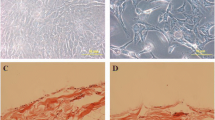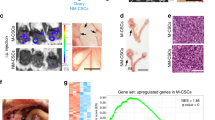Abstract
Background and aims
Intraperitoneal tumor cell adhesion to extracellular matrix and to mesothelial cells mediated by integrins is an important step in developing peritoneal carcinosis. In former animal studies, we could demonstrate that intraperitoneal treatment with a new phospholipid (PL) emulsion significantly reduces the amount of peritoneal carcinosis by adhesion prevention. This in vitro study tries to elucidate the influence of phospholipids on cells of the human gastric cancer cell line (NUGC-4) and the human rectal cancer cell line (HRT-18) adhering to mesothelial cells (HOMC) in a monolayer culture in vitro.
Materials and methods
HOMC cells were derived from omentum majus from patients undergoing elective abdominal surgery. Three passages of both cancer cell lines (NUGC-4 and HRT-18) were used. 1×105/100 μl (HRT-18) or 1.2×105/100 μl (NUGC-4) cells, according to forgoing dilution series, were pretreated with different concentrations of phospholipid emulsion (0.05, 0.1, 0.5, 0.75, 1% PL) stained with cell tracker chloromethyl-benzamidodialkylcarbocyanine (CM-DIL) and seeded into each well on the mesothelial monolayer. After 90 min, the number of adherent cells was counted by fluorescence microscopy at 530 and 620 nm. Additionally, flow cytometric analysis of integrin α3 and β1 expression on the tumor cell surface after treatment with phospholipids was completed.
Results
We found a dose dependent effect of phospholipids on both tumor cell lines causing a reduction of cell–cell adhesion. Already low concentrations of phospholipids (PL 0.5) had a significant influence. The mean cell count could be reduced from 234±12/mm2 in controls to 124±41/mm2 (PL 0.5; NUG-4) and from 295±49/mm2 to 169±29/mm2 (PL 0.5; HRT-18), respectively. Additionally, the integrin α3 and β1 expression on both cell lines could be reduced.
Conclusion
Our results within the scope of published data indicate that adhesion prevention is capable to reduce peritoneal carcinosis.






Similar content being viewed by others
References
Schott A, Vogel I, Krueger U, Kalthoff H, Schreiber HW, Schmiegel W, Henne-Bruns D, Kremer B, Juhl H (1998) Isolated tumor cells are frequently detectable in the peritoneal cavity of gastric and colorectal cancer patients and serve as a new prognostic marker. Ann Surg 227(3):372–379
Broll R, Lembcke K, Stock C, Zingler M, Duchrow M, Schimmelpenning H, Strik M, Muller G, Kujath P, Bruch HP (1996) Tumor cell dissemination in bone marrow and peritoneal cavity. An immunocytochemical study of patients with stomach or colorectal carcinoma. Langenbecks Arch Chir 381(1):51–58
Kiyasu Y, Kaneshima S, Koga S (1981) Morphogenesis of peritoneal metastasis in human gastric cancer. Cancer Res 41(3):1236–1239
Schwartz GK (1996) Invasion and metastases in gastric cancer: in vitro and in vivo models with clinical correlations. Semin Oncol 23(3):316–324
Koga S, Kudo H, Kiyasu Y, Kaneshima S, Iitsuka Y, Takeuchi T, Tanida O (1980) A scanning electron microscopic study on the peritoneal implantation of ascites hepatoma AH100B cells in rats. Gann 71(1):8–13
Cronauer MV, Stadlmann S, Klocker H, Abendstein B, Eder IE, Rogatsch H, Zeimet AG, Marth C, Offner FA (1999) Basic fibroblast growth factor synthesis by human peritoneal mesothelial cells: induction by interleukin-1. Am J Pathol 155(6):1977–1984
Lanfrancone L, Boraschi D, Ghiara P, Falini B, Grignani F, Peri G, Mantovani A, Pelicci PG (1992) Human peritoneal mesothelial cells produce many cytokines (granulocyte colony-stimulating factor [CSF], granulocyte-monocyte-CSF, macrophage-CSF, interleukin-1 [IL-1], and IL-6) and are activated and stimulated to grow by IL-1. Blood 1-12-80(11):2835–2842
Douvdevani A, Rapoport J, Konforty A, Argov S, Ovnat A, Chaimovitz C (1994) Human peritoneal mesothelial cells synthesize IL-1 alpha and beta. Kidney Int 46(4):993–1001
Offner FA, Feichtinger H, Stadlmann S, Obrist P, Marth C, Klingler P, Grage B, Schmahl M, Knabbe C (1996) Transforming growth factor-beta synthesis by human peritoneal mesothelial cells. Induction by interleukin-1. Am J Pathol 148(5):1679–1688
Muller SA, Treutner KH, Tietze L, Anurov M, Titkova S, Polivoda M, Oettinger AP, Schumpelick V (2001) Influence of intraperitoneal phospholipid dosage on adhesion formation and wound healing at different intervals after surgery. Langenbecks Arch Surg 386(4):278–284
Muller SA, Treutner KH, Tietze L, Anurov M, Titkova S, Polivoda M, Oettinger AP, Schumpelick V (2001) Efficacy of adhesion prevention and impact on wound healing of intraperitoneal phospholipids. J Surg Res 96(1):68–74
Treutner KH, Schumpelick V (2000) Prevention of adhesions. Wish and reality. Chirurg 71(5):510–517
Beavis J, Harwood JL, Coles GA, Williams JD (1994) Synthesis of phospholipids by human peritoneal mesothelial cells. Perit Dial Int 14(4):348–355
Chailley-Heu B, Rubio S, Rougier JP, Ducroc R, Barlier-Mur AM, Ronco P, Bourbon JR (1997) Expression of hydrophilic surfactant proteins by mesentery cells in rat and man. Biochem J 15-11-328(Pt 1):251–256
Hakomori S (2003) Structure, organization, and function of glycosphingolipids in membrane. Curr Opin Hematol 10(1):16–24
Tietze L, Borntraeger J, Klosterhalfen B, Amo-Takyi B, Handt S, Gunther K, Merkelbach-Bruse S (1999) Expression and function of beta(1) and beta(3) integrins of human mesothelial cells in vitro. Exp Mol Pathol 66(2):131–139
Welch DR, Fabra A, Nakajima M (1990) Transforming growth factor beta stimulates mammary adenocarcinoma cell invasion and metastatic potential. Proc Natl Acad Sci USA 87(19):7678–7682
Hynes RO (1992) Integrins: versatility, modulation, and signaling in cell adhesion. Cell 3-4-69(1):11–25
Mould AP, Askari JA, Aota S, Yamada KM, Irie A, Takada Y, Mardon HJ, Humphries MJ (1997) defining the topology of integrin alpha5beta1-fibronectin interactions using inhibitory anti-alpha5 and anti-beta1 monoclonal antibodies. Evidence that the synergy sequence of fibronectin is recognized by the amino-terminal repeats of the alpha5 subunit. J Biol Chem 11-7-272(28):17283–17292
Mould AP, Garratt AN, Askari JA, Akiyama SK, Humphries MJ (1995) Identification of a novel anti-integrin monoclonal antibody that recognises a ligand-induced binding site epitope on the beta 1 subunit. FEBS Lett 17-4-363(1-2):118–122
Yamada KM, Kennedy DW, Yamada SS, Gralnick H, Chen WT, Akiyama SK (1990) Monoclonal antibody and synthetic peptide inhibitors of human tumor cell migration. Cancer Res 1-8-50(15):4485–4496
Gehlsen KR, Argraves WS, Pierschbacher MD, Ruoslahti E (1988) Inhibition of in vitro tumor cell invasion by arg-gly-asp-containing synthetic peptides. J Cell Biol 106(3):925–930
Mould AP, Askari JA, Akiyama SK, Yamada KM, Humphries MJ (1991) An assessment of the efficacy of anti-integrin alpha subunit monoclonal antibody production using affinity purified beta 1-integrin dimers as immunogen. Biochem Soc Trans 19(4):361S
Gui GP, Puddefoot JR, Vinson GP, Wells CA, Carpenter R (1995) In vitro regulation of human breast cancer cell adhesion and invasion via integrin receptors to the extracellular matrix. Br J Surg 82(9):1192–1196
Nakashio T, Narita T, Akiyama S, Kasai Y, Kondo K, Ito K, Takagi H, Kannagi R (1997) Adhesion molecules and TGF-Beta1 are involved in the peritoneal dissemination of NUGC-4 human gastric cancer cells. Int J Cancer 4-3-70(5):612–668
Wilson JR, Weiser MM (1992) Colonic Cancer Cell (HT29) Adhesion to laminin is altered by differentiation: adhesion may involve galactosyltransferase. Exp Cell Res 201(2):330–334
Aznavoorian S, Murphy AN, Stetler-Stevenson WG, Liotta LA (1993) Molecular aspects of tumor cell invasion and metastasis. Cancer 15-2-71(4):1368–1383
Yashiro M, Chung YS, Nishimura S, Inoue T, Sowa M (1996) Fibrosis in the peritoneum induced by scirrhous gastric cancer cells may act as “soil” for peritoneal dissemination. Cancer 15-4-77(8 Suppl):1668–1675
Hakomori S, Zhang Y (1997) Glycosphingolipid antigens and cancer therapy. Chem Biol 4(2):97–104
van Rossen ME, Hofland LJ, van den Tol MP, van Koetsveld PM, Jeekel J, Marquet RL, van Eijck CH (2001) Effect of inflammatory cytokines and growth factors on tumour cell adhesion to the peritoneum. J Pathol 193(4):530–537
Jansen M, Treutner KH, Jansen PL, Zuber S, Otto J, Tietze L, Schumpelick V (2005) Inhibition of gastric cancer cell adhesion in nude mice by intraperitoneal phospholipids. World J Surg 29(6):708–714
Jansen M, Treutner KH, Schmitz B, Otto J, Jansen PL, Neuss S, Schumpelick V (2004) Phospholipids reduce gastric cancer cell adhesion to extracellular matrix in vitro. BMC Gastroenterol 29-12-4(1):33
Jansen M, Treutner KH, Jansen PL, Otto J, Schmitz B, Mueller S, Weiss C, Tietze L, Schumpelick V (2004) Phospholipids reduce the intraperitoneal adhesion of colonic tumor cells in rats and adhesion on extracellular matrix in vitro. Int J Colorectal Dis 19(6):525–532
Pross M, Lippert H, Misselwitz F, Nestler G, Kruger S, Langer H, Halangk W, Schulz HU (2003) low-molecular-weight heparin (reviparin) diminishes tumor cell adhesion and invasion in vitro, and decreases intraperitoneal growth of colonadeno-carcinoma cells in rats after laparoscopy. Thromb Res 1-6-110(4):215–220
Author information
Authors and Affiliations
Corresponding author
Rights and permissions
About this article
Cite this article
Jansen, M., Lynen Jansen, P., Otto, J. et al. The inhibition of tumor cell adhesion on human mesothelial cells (HOMC) by phospholipids in vitro. Langenbecks Arch Surg 391, 96–101 (2006). https://doi.org/10.1007/s00423-006-0025-9
Received:
Accepted:
Published:
Issue Date:
DOI: https://doi.org/10.1007/s00423-006-0025-9




